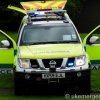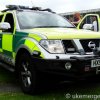L999 ADG Team Services Volvo V70 seen as medical cover on a film
L999 ADG Team Services Volvo V70 seen as medical cover on a film set. The car carries no obvious signage to show which organisation it belongs to except for a small sticker on the registration plate. The Chelmsford-based company provides medics and ambulances for TV and film work. The car carries the personalised registration of the owner Alex Gardner.
































































































